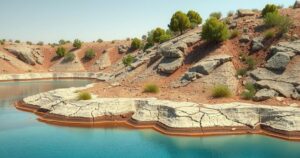Climate Change Intensifies Red Spider Mite Infestation in Libya, Threatening Agriculture

In Libya, the red spider mite infestation, worsened by climate change, is causing catastrophic crop losses. With the ability to reproduce rapidly in hot, arid conditions, these pests have devastated fruit and vegetable production, particularly in the Wadi Al-Hai agricultural project. Experts emphasize the need for integrated pest management strategies and improved monitoring practices to combat this growing agricultural crisis.
The escalating crisis from the red spider mite infestation in Libya, exacerbated by climate change, has resulted in significant agricultural devastation, particularly in northwestern regions. Tiny red spider mites, less than half a millimeter in size, have wreaked havoc by feeding on various plants, leading to drastically decreased yields. Farmers involved in the Wadi Al-Hai agricultural development project expressed grave concerns as many fruit and vegetable crops were obliterated by this pest this year. Fathi Al-Tahir, a plant protection expert at the Ministry of Agriculture and Animal Resources under the Government of National Unity in Libya, noted that the mite issue has worsened remarkably in recent years, citing climate alterations as a contributing factor. The Wadi Al-Hai project, sprawling over 12,000 hectares and hosting over 400 farms, is heavily reliant on the cultivation of fruit trees like figs, pomegranates, and grapes. The rapid reproduction capabilities of red spider mites, particularly in hot, dry conditions, have made them especially destructive. Having originated in North Africa in the mid-20th century, these pests have continuously spread to neighboring countries including Morocco, Algeria, Tunisia, and Egypt. Jamal Breim, a local farmer, recounted the intense infestation that began on his farm in 2017, severely impacting his fruit production and rendering pesticide applications ineffective due to their poor quality. Notably, the last two years have demonstrated optimal conditions for mite proliferation, with decreased rainfall and increased temperatures accelerating their life cycle. Al-Tahir warned against the blanket use of non-specific pesticides, as this could lead to resistance among pest populations. Poor management practices could aggravate the situation, compromising older pest control methods, according to Rachid Boulmatat from the International Center for Agricultural Research in the Dry Areas (ICARDA). Recommendations for addressing the issue include strengthening pest quarantine systems, enhancing farmer training programs, and implementing integrated pest control strategies. The ramifications of red spider mite infestations encompass a broader agricultural landscape, having grown from western regions across Libya. Abdul Majeed Al-Baghdadi from Libya’s National Center for Prevention and Agricultural Quarantine indicated that the pest has affected multiple regions. He highlighted the intention to initiate a nationwide campaign against the mites, contingent on stable security and budgetary provisions.
Climate change is a pressing issue that has generated significant concern globally, impacting various sectors, including agriculture. In Libya, rising temperatures and reduced rainfall have created ideal environments for red spider mites, particularly in agriculturally rich areas. This has resulted in a stark increase in their populations, leading to widespread crop failures and imposing severe economic burdens on farmers. Understanding the behavior and biological patterns of red spider mites is critical to mitigating the impacts of their infestations. Observations and studies have shown that climate extremes favor their rapid reproduction and dispersion, highlighting the interplay between environmental factors and pest management.
In summary, the red spider mite infestation in Libya represents a significant challenge for local agriculture, driven largely by adverse climate conditions. Farmers are facing unprecedented crop damage, with rising temperatures and decreased rainfall creating fertile grounds for these pests. The primary strategies to combat this issue involve improved insect management practices, enhanced training for farmers, and proper monitoring systems. Immediate action is required to mitigate the damage and secure food production in the region.
Original Source: phys.org






